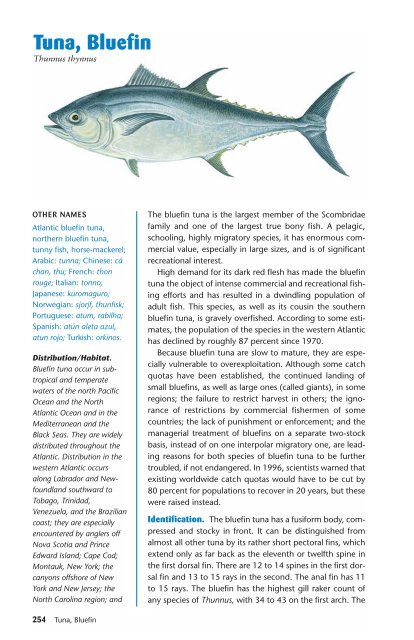Ken Schultz's Field Guide to Saltwater Fish - Macaw Pets store
Ken Schultz's Field Guide to Saltwater Fish - Macaw Pets store
Ken Schultz's Field Guide to Saltwater Fish - Macaw Pets store
Create successful ePaper yourself
Turn your PDF publications into a flip-book with our unique Google optimized e-Paper software.
Tuna, Bluefin<br />
Thunnus thynnus<br />
OTHER NAMES<br />
Atlantic bluefin tuna,<br />
northern bluefin tuna,<br />
tunny fish, horse-mackerel;<br />
Arabic: tunna; Chinese: cá<br />
chan, thu; French: thon<br />
rouge; Italian: <strong>to</strong>nno;<br />
Japanese: kuromaguro;<br />
Norwegian: sjorjf, thunfisk;<br />
Portuguese: atum, rabilha;<br />
Spanish: atún aleta azul,<br />
atun rojo; Turkish: orkinos.<br />
Distribution/Habitat.<br />
Bluefin tuna occur in subtropical<br />
and temperate<br />
waters of the north Pacific<br />
Ocean and the North<br />
Atlantic Ocean and in the<br />
Mediterranean and the<br />
Black Seas. They are widely<br />
distributed throughout the<br />
Atlantic. Distribution in the<br />
western Atlantic occurs<br />
along Labrador and Newfoundland<br />
southward <strong>to</strong><br />
Tobago, Trinidad,<br />
Venezuela, and the Brazilian<br />
coast; they are especially<br />
encountered by anglers off<br />
Nova Scotia and Prince<br />
Edward Island; Cape Cod;<br />
Montauk, New York; the<br />
canyons offshore of New<br />
York and New Jersey; the<br />
North Carolina region; and<br />
254 Tuna, Bluefin<br />
The bluefin tuna is the largest member of the Scombridae<br />
family and one of the largest true bony fish. A pelagic,<br />
schooling, highly migra<strong>to</strong>ry species, it has enormous commercial<br />
value, especially in large sizes, and is of significant<br />
recreational interest.<br />
High demand for its dark red flesh has made the bluefin<br />
tuna the object of intense commercial and recreational fishing<br />
efforts and has resulted in a dwindling population of<br />
adult fish. This species, as well as its cousin the southern<br />
bluefin tuna, is gravely overfished. According <strong>to</strong> some estimates,<br />
the population of the species in the western Atlantic<br />
has declined by roughly 87 percent since 1970.<br />
Because bluefin tuna are slow <strong>to</strong> mature, they are especially<br />
vulnerable <strong>to</strong> overexploitation. Although some catch<br />
quotas have been established, the continued landing of<br />
small bluefins, as well as large ones (called giants), in some<br />
regions; the failure <strong>to</strong> restrict harvest in others; the ignorance<br />
of restrictions by commercial fishermen of some<br />
countries; the lack of punishment or enforcement; and the<br />
managerial treatment of bluefins on a separate two-s<strong>to</strong>ck<br />
basis, instead of on one interpolar migra<strong>to</strong>ry one, are leading<br />
reasons for both species of bluefin tuna <strong>to</strong> be further<br />
troubled, if not endangered. In 1996, scientists warned that<br />
existing worldwide catch quotas would have <strong>to</strong> be cut by<br />
80 percent for populations <strong>to</strong> recover in 20 years, but these<br />
were raised instead.<br />
Identification. The bluefin tuna has a fusiform body, compressed<br />
and s<strong>to</strong>cky in front. It can be distinguished from<br />
almost all other tuna by its rather short pec<strong>to</strong>ral fins, which<br />
extend only as far back as the eleventh or twelfth spine in<br />
the first dorsal fin. There are 12 <strong>to</strong> 14 spines in the first dorsal<br />
fin and 13 <strong>to</strong> 15 rays in the second. The anal fin has 11<br />
<strong>to</strong> 15 rays. The bluefin has the highest gill raker count of<br />
any species of Thunnus, with 34 <strong>to</strong> 43 on the first arch. The


